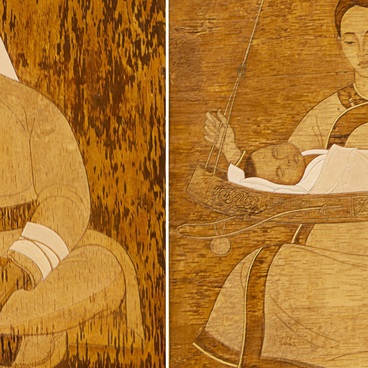Nikolay Alekseyevich Karpov was born in Novosibirsk Oblast in 1952. His father, a painter by trade, became his first mentor: the boy often joined him on plein airs, and ever since childhood, he drew and knew the secrets of the craft.
In 1966, the Karpov family moved to the town of Murom in the Vladimir region — the birthplace of the artist’s mother. There, Nikolay enrolled in middle school and studied in an art studio under Mikhail Konstantinovich Lyovin. It was also in Murom that he presented his works for the first time at town exhibitions. In 1970, Karpov graduated from middle school and, following his father’s advice, entered the art and graphics department of the Moscow State Institute of the Order of the Red Banner of Labor.
Nikolay Karpov was assigned to Komsomolsk-on-Amur as a teacher of fine arts, and he successfully combined teaching with his own artistic endeavors. His works drew the attention of fellow artists. In 1980, through the recommendation of Alexey Vasilyevich Mashchenko, a member of the Union of Artists, Nikolay Karpov started working at artistic and industrial workshops. He was also engaged in art and design activities. In 1996, he became a member of the Artists’ Union of Artists.
The painting “Silvery Amur” got its name from the silvery sun-glade on the water. Although the sun itself is not present, it is still clear that the painting depicts a warm fair day. The river occupies two-thirds of the pictorial space, the horizon line is raised, revealing the wide expanses of the Amur River.
According to old Nanai legends, the Amur River is a giant dragon and the master of all fish living in those waters. The constant changes in the streambed’s structure were explained by its stirring.
The viewer is brought back to the reality of the modern world by the image of the bridge over the Amur River in the upper right corner — an outstanding example of Russian bridge engineering.
Researchers and other artists have distinguished Nikolay Karpov’s works for the vividness of plein-air painting and their warm and pleasing colors.
In 1966, the Karpov family moved to the town of Murom in the Vladimir region — the birthplace of the artist’s mother. There, Nikolay enrolled in middle school and studied in an art studio under Mikhail Konstantinovich Lyovin. It was also in Murom that he presented his works for the first time at town exhibitions. In 1970, Karpov graduated from middle school and, following his father’s advice, entered the art and graphics department of the Moscow State Institute of the Order of the Red Banner of Labor.
Nikolay Karpov was assigned to Komsomolsk-on-Amur as a teacher of fine arts, and he successfully combined teaching with his own artistic endeavors. His works drew the attention of fellow artists. In 1980, through the recommendation of Alexey Vasilyevich Mashchenko, a member of the Union of Artists, Nikolay Karpov started working at artistic and industrial workshops. He was also engaged in art and design activities. In 1996, he became a member of the Artists’ Union of Artists.
The painting “Silvery Amur” got its name from the silvery sun-glade on the water. Although the sun itself is not present, it is still clear that the painting depicts a warm fair day. The river occupies two-thirds of the pictorial space, the horizon line is raised, revealing the wide expanses of the Amur River.
According to old Nanai legends, the Amur River is a giant dragon and the master of all fish living in those waters. The constant changes in the streambed’s structure were explained by its stirring.
The viewer is brought back to the reality of the modern world by the image of the bridge over the Amur River in the upper right corner — an outstanding example of Russian bridge engineering.
Researchers and other artists have distinguished Nikolay Karpov’s works for the vividness of plein-air painting and their warm and pleasing colors.

